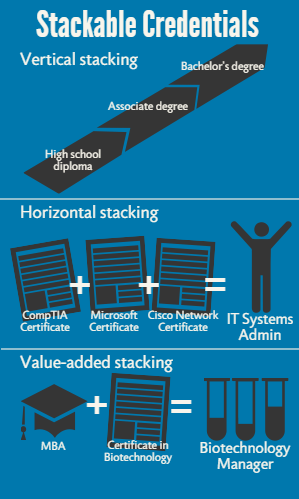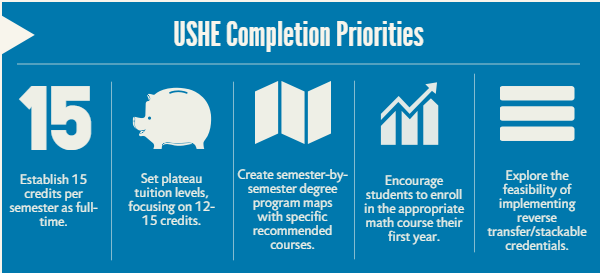In July 2013, the Utah State Board of Regents, with the support of presidents in the Utah System of Higher Education (USHE), adopted a Completion Resolution, which encourages the implementation of five key strategies to improve college completion in the state.
What is reverse transfer? A stackable credential?
Reverse Transfer
Reverse transfer is a process where academic credits for course work completed at a four-year university are transferred back to the previously-attended community college to satisfy associate degree requirements. Some students transfer into four-year universities before completing an associate degree at a community college, with a percentage of this group eventually gaining a bachelor’s degree through a combination of credits from both institutions. Through reverse transfer, a student’s achievements are recognized with an associate degree after they have transferred to a four-year school and have accumulated the credits needed to fulfill the two-year degree program requirements.
Benefits and rationale:
- Students who are awarded an associate degree are more likely to stay in school and finish a four-year degree program.
- Graduates will have two degrees on their resumes, more accurately reflecting their skills and training over time.
- Students who do not complete a four-year degree will at least have a credential, helping with career goals. If they decide to return and complete a bachelor’s at a later date, transferring will be easier, and they will move more quickly towards completion.
Stackable credentials

Salt Lake Community College has made a concerted effort to ensure stackability of certificates to associate degree programs. At last report, SLCC has defined vertical pathways for 95 certificates and degrees. As a result, the number of certificates SLCC has awarded has increased 52% since the 2012-13 academic year.
According to the US Department of Labor, a “stackable credential” is part of a sequence of credentials that can be accumulated over time to build up an individual’s qualifications and help them to move along a career pathway or up a career ladder to different and potentially higher-paying jobs.
There are many ways to stack a credential:
Vertical stacking
This is the general way stacking is thought of, with one credential combined with another to progress toward a higher credential.
Example: High school diploma > Associate degree > Bachelor’s degree
Horizontal stacking
In this type of stacking, a student earns a variety of credentials in related fields that, when taken collectively, prepare them for a specific type of job.
Example: Certificate in CompTIA (IT) + Certificate in Microsoft Certified Solutions Expert (MCSE) + Certificate in Cisco Certified Network Associate (CCNA) = job as IT systems administrator
Value-added stacking
This pertains to adding an area of expertise to an existing degree in order to be better prepared for a specific type of job.
Example: MBA + Certificate in Biotechnology = job as biotechnology manager
This article is one of several periodic updates on the efforts of USHE institutions towards improving student completion in meaningful ways. Additional information on current efforts and goals that were approved by the Board of Regents in January 2015 is available here.

